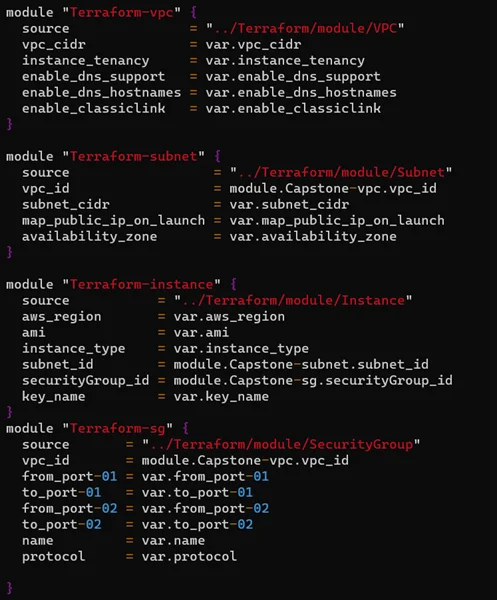|
Voiced by Amazon Polly |
Overview
Infrastructure as Code (IaC) has evolved as a disruptive concept in the ever-evolving world of DevOps and cloud computing, allowing teams to provide, manage, and scale infrastructure through code. Terraform stands out as a strong option among the technologies that have become quite popular in the IaC space, offering a mechanism to describe infrastructure declaratively. It is possible to write modular, reusable code using Terraform modules, which is one of its main advantages. This blog will explore what Terraform modules are, why they are important, and how they help teams create effective and scalable infrastructure.
Pioneers in Cloud Consulting & Migration Services
- Reduced infrastructural costs
- Accelerated application deployment
Introduction
Think about Terraform modules as the traditional programming language’s equivalent of functions, allowing you to build a structured, modular infrastructure codebase.
Benefits of Using Terraform Modules
- Reusability and Consistency: Terraform modules encourage a repeatable and consistent method for provisioning infrastructure. Once a module is developed, it can be utilized in various applications and settings, maintaining consistency and lowering the possibility of errors.
- Simplified Maintenance: Teams can manage and update infrastructure components independently with the help of modules. Modifications to a module spread to all instances where it is utilized, simplifying maintenance and updates.
- Encapsulation and abstraction: Modules encapsulate complicated infrastructure elements, decreasing cognitive strain and making code easier to understand. Because of the abstraction, users can concentrate on the goals of the module rather than its internal workings.
- Scalability: By reusing tried-and-true components, modules let you scale effectively as your infrastructure grows. The capacity to manage complex and vast infrastructure systems depends on this scalability.
Creating and Using Terraform Modules
Defining the resources, variables, and logic necessary for a particular piece of infrastructure is necessary when creating a Terraform module. Each module has its directory and can be arranged using a directory structure. Let’s review a straightforward example of building and utilizing a Terraform module.
Module Creation: To provision an Amazon EC2 instance, let’s say you wish to construct a module. You would define any necessary variables, resources, and logic within the module directory.
Module usage: You may call this module by giving the module’s variables input values in your main Terraform setup. This hides behind a single module called the complexity of establishing an Amazon EC2 instance.
Module Output: Modules can also specify output variables that let you access data from the module, like resource identifiers, IP addresses, and other pertinent information.


Best Practices for Using Terraform Modules
- Modularity and Abstraction: Create modules that are abstract and modular. Each module should offer a distinct functionality and a clean, well-defined interface.
- Input Validation: Implement input validation inside modules to ensure that the right values are supplied, lowering the possibility of misconfiguration.
- Versioning and Documentation: To guarantee backward compatibility and offer explicit documentation for module usage and inputs, adhere to versioning practices.
- Testing: Test modules to ensure they function as expected and result appropriately when called.
Conclusion
A key component of efficiently utilizing Infrastructure as Code is Terraform modules. Modules enable teams to develop and manage complex infrastructure settings more effectively by fostering reuse, consistency, and scalability. As you begin your exploration of Terraform, remember that learning modules can greatly improve your capacity to write maintainable, modular, and instinctive infrastructure code. Accept the power of Terraform modules and use Infrastructure as Code to its fullest in your applications.
Drop a query if you have any questions regarding Terraform Modules and we will get back to you quickly.
Making IT Networks Enterprise-ready – Cloud Management Services
- Accelerated cloud migration
- End-to-end view of the cloud environment
About CloudThat
CloudThat is an award-winning company and the first in India to offer cloud training and consulting services worldwide. As a Microsoft Solutions Partner, AWS Advanced Tier Training Partner, and Google Cloud Platform Partner, CloudThat has empowered over 850,000 professionals through 600+ cloud certifications winning global recognition for its training excellence including 20 MCT Trainers in Microsoft’s Global Top 100 and an impressive 12 awards in the last 8 years. CloudThat specializes in Cloud Migration, Data Platforms, DevOps, IoT, and cutting-edge technologies like Gen AI & AI/ML. It has delivered over 500 consulting projects for 250+ organizations in 30+ countries as it continues to empower professionals and enterprises to thrive in the digital-first world.
FAQs
1. What are the best practices for creating Terraform modules?
ANS: – Some best practices for developing Terraform modules are keeping modules focused on a single issue, defining meaningful input and output variable names, providing thorough documentation, using appropriate naming conventions, and adhering to versioning and semantic versioning principles.
2. What are the best ways to distribute and reuse Terraform modules?
ANS: – By keeping Terraform modules in version control programs (like Git) and hosting them on websites like GitHub or Terraform Registry, you can share them. The module source URL can refer to these modules in other users’ Terraform code.

WRITTEN BY Vaishali Bhawsar
Vaishali is working as a Research Associate in CloudThat Technologies. She has good knowledge of Networking, Linux systems & C language, and currently working on various AWS projects along with, Terraform, Docker, and Ansible. She enjoys painting and cooking during her free time.


 Login
Login


 September 11, 2023
September 11, 2023 PREV
PREV











Comments